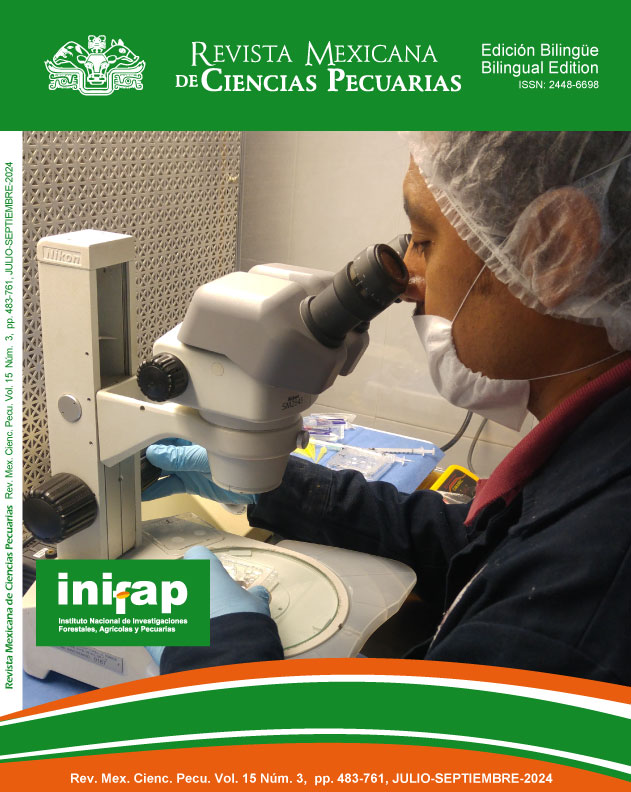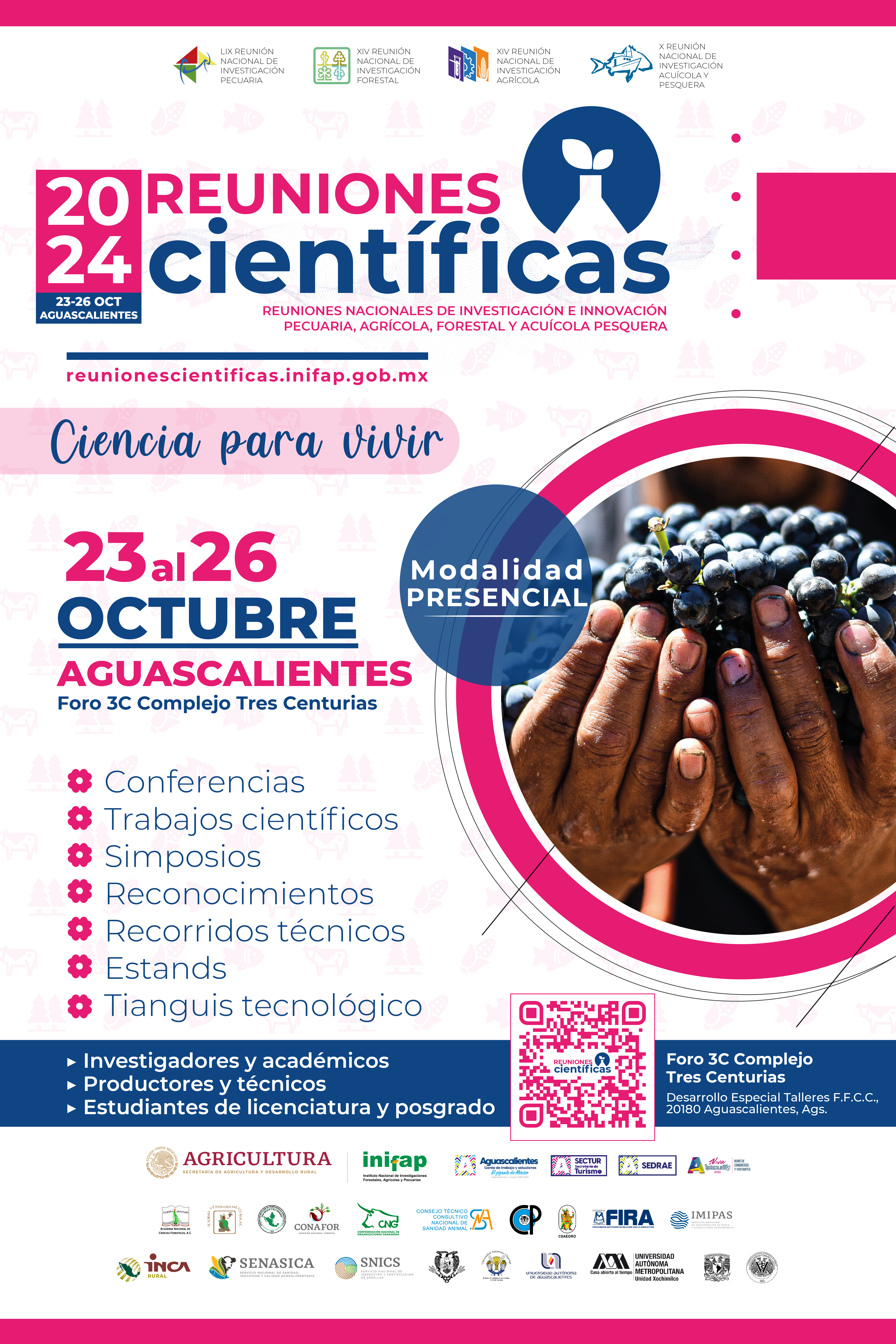Fatty acids and terpenes from the methanolic extract of Artemisia cina as possible compounds responsible for the ovicidal effect on Haemonchus contortus
DOI:
https://doi.org/10.22319/rmcp.v15i3.6468Keywords:
Artemisia cina, Haemonchus contortus, Egg hatching, AnthelminticAbstract
Haemonchus contortus is a hematophagous nematode with a high reproduction rate, considered to be the main problem in grazing small ruminants. Therefore, treatment alternatives based on the use of plant extracts are sought. This study aimed to evaluate the ovicidal activity of Artemisia cina against the parasite Haemonchus contortus and to chemically characterize the extract with the highest biological activity through gas chromatography coupled with mass spectrometry (GC-MS). The extracts to be evaluated were obtained through the maceration technique using methanol, ethyl acetate, and n-hexane. The extracts were taken to total dryness and challenged against H. contortus eggs using the egg-hatching inhibition technique described by the World Association for the Advancement of Veterinary Parasitology (WAAVP). The methanolic extract (ME) showed 100 % ovicidal activity at a concentration of 4.25 mg/ml, being the most active at a low concentration; therefore, it was characterized by GC-MS. ME mainly contains fatty acids and terpenes; among them are hexadecanoic acid and 2-[4-methyl-6-(2,6,6-trimethylcyclohex-1-enyl)hexa-1,3,5-trienyl][cyclohex]-1-en-carboxyaldehyde. The characterized compounds have shown previously reported anthelmintic activity so that ovicidal activity may be associated with them. In conclusion, the methanolic extract of A. cina had a higher ovicidal activity at low concentrations; this is probably due to the presence of fatty acids and terpenes.
Downloads
References
Mohamed HI, Arafa WM, El-Dakhly KM. Prevalence and associated risk factors of gastrointestinal helminths and coccidian infections in domestic goats, Capra hircus, in Minya, Egypt. Beni Suef Univ J Basic Appl Sci 2023;12(1):29. doi:10.1186/s43088-023-00369-6.
Jackson F, Coop RL. The development of anthelmintic resistance in sheep nematodes. Parasitology 2000;120(7):95-107. doi:10.1017/S0031182099005740.
Dolinská MU, Königová A, von Samson Himmelstjerna G, Várady M. Variation in allele frequencies in benzimidazole resistant and susceptible isolates of Haemonchus contortus during patent infection in lambs. Sci Rep 2023;13(1):1296. doi:10.1038/s41598-023-28168-0.
Sabatini GA, de Almeida Borges F, Claerebout E, et al. Practical guide to the diagnostics of ruminant gastrointestinal nematodes, liver fluke and lungworm infection: interpretation and usability of results. Parasit Vectors 2023;16(1):58. doi:10.1186/s13071-023-05680-w.
Badar SN, Sajid MS, Rizwan HM, et al. In vitro and in vivo anthelmintic response of the seeds of Amomum subulatum roxb and Vitex negundo. Brazilian J Biol 2024;84. doi:10.1590/1519-6984.261768.
George MM, Vatta AF, Howell SB, et al. Evaluation of changes in drug susceptibility and population genetic structure in Haemonchus contortus following worm replacement as a means to reverse the impact of multiple-anthelmintic resistance on a sheep farm. Int J Parasitol Drugs Drug Resist 2021;15:134-143. doi:10.1016/j.ijpddr.2021.02.004.
Irum S, Ahmed H, Mukhtar M, et al. Anthelmintic activity of Artemisia vestita Wall ex DC. and Artemisia maritima L. against Haemonchus contortus from sheep. Vet Parasitol 2015;212(3-4):451-455. doi:10.1016/j.vetpar.2015.06.028.
Turi CE, Shipley PR, Murch SJ. North American Artemisia species from the subgenus Tridentatae (Sagebrush): A phytochemical, botanical and pharmacological review. Phytochemistry 2014;98:9-26. doi:10.1016/j.phytochem.2013.11.016.
Higuera-Piedrahita RI, Dolores-Hernández M, Cruz-Cruz HA de la, et al. 3′-Demethoxy-6-O- Demethylisoguaiacin and Norisoguaiacin Nematocidal Lignans from Artemisia cina against Haemonchus contortus Infective Larvae. Plants 2023;12(4):820. doi:10.3390/plants12040820.
Sakipova Z, Giorno TBS, Bekezhanova T, et al. Pharmacological evaluation of Artemisia cina crude CO2 subcritical extract after the removal of santonin by means of high speed countercurrent chromatography. Molecules 2020;25(12):2728. doi:10.3390/molecules25122728.
Meng Y, Ma N, Lyu H, et al. Recent pharmacological advances in the repurposing of artemisinin drugs. Med Res Rev 2021;41(6):3156-3181. doi:10.1002/med.21837.
Montes Zaragoza LA. Propiedades terapéuticas del género artemisia presente en Tijuana, uso y alternativa económica en población de escasos recursos [tesis maestría]. Tijuana, Baja California. Universidad Autónoma de Baja California, 2015.
Coles GC, Bauer C, Borgsteede FHM, et al. World Association for the Advancement of Veterinary Parasitology (W.A.A.V.P.) methods for the detection of anthelmintic resistance in nematodes of veterinary importance. Vet Parasitol 1992;44(1-2):35-44. doi:10.1016/0304-4017(92)90141-U.
Pineda-Alegría JA, Sánchez JE, González-Cortazar M, et al. In vitro nematocidal activity of commercial fatty acids and β-sitosterol against Haemonchus contortus. J Helminthol 2020;94:e135. doi:10.1017/S0022149X20000152.
Cascorbi I. Arzneimittelinteraktionen: Prinzipien, Beispiele und klinische Folgen. Dtsch Arztebl Int 2012;109(33-34):546-556. doi:10.3238/arztebl.2012.0546.
Fantatto RR, Chagas AC de S, Gainza YA, et al. Acaricidal and anthelmintic action of ethanolic extract and essential oil of Achyrocline satureioides. Exp Parasitol 2022;236-237. doi:10.1016/j.exppara.2022.108252.
Liu J, Zhu J, Xue J, et al. In silico-based screen synergistic drug combinations from herb medicines: A case using Cistanche tubulosa. Sci Rep 2017;7(1). doi:10.1038/s41598-017-16571-3.
Wink M. Modes of action of herbal medicines and plant secondary metabolites. Medicines 2015;2(3):251-286. doi:10.3390/medicines2030251.
Higuera-Piedrahita RI, López-Arellano ME, López-Arellano R, Cuenca-Verde C, Cuéllar-Ordaz JA. Evaluación del efecto de las artemisininas provenientes del extracto etanólico de Artemisia cina sobre L3 de Haemonchus contortus en una técnica de explantes abomasales. Ciencia y Agricultura 2016;13(1):107-116. https://www.redalyc.org/articulo.oa?id=560062814009.
Higuera-Piedrahita RI, Dolores-Hernández M, Jiménez-Pérez LG, et al. In vitro nematocidal effect and anthelmintic activity of Artemisia cina against Haemonchus contortus in gerbils and relative expression of hc29 gene in transitional larvae (l3–l4). Acta Parasitol 2021;66(3):938-946. doi:10.1007/s11686-021-00364-w.
Higuera-Piedrahita RI, Dolores-Hernández M, de la-Cruz-Cruz HA, et al. An Artemisia cina n-hexane extract reduces the Haemonchus contortus and Teladorsagia circumcincta fecal egg count in naturally infected periparturient goats. Trop Anim Health Prod 2022;54(2). doi:10.1007/s11250-022-03103-z.
Downloads
Published
How to Cite
-
Abstract92
-
PDF (Español)29
-
PDF8
-
Texto completo (Español)6
-
Full text4
Issue
Section
License

This work is licensed under a Creative Commons Attribution-NonCommercial-ShareAlike 4.0 International License.

This work is licensed under a Creative Commons Attribution-NonCommercial-ShareAlike 4.0 International License.






